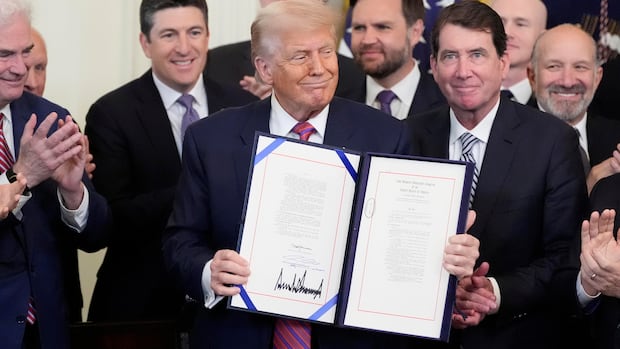Stablecoins could transform how we exchange money. The U.S. and China want to take charge

Like a 21st-century space race, the world's biggest economic powers are staking their claim in a little-known type of digital currency that could revolutionize — or severely disrupt — the way people, companies and countries exchange money.
Stablecoins are a type of cryptocurrency pegged to a country's national currency, or to commodities like gold. The idea is that their value is linked to a stable asset, and is therefore less prone to volatility than regular crypto.
Think of it as a "digital dollar": Stablecoins have a one-for-one exchange rate with their real-world twins, which investors keep in a reserve as collateral against more volatile types of crypto. The digital coins are designed to be converted into the material asset that they're linked to at any moment, from anywhere in the world, and without extra costs.
"Right now, obviously, stablecoins are not super popular. You can't go into a Loblaws and pay for your groceries with stablecoins," said Claire Wilson, a policy and research analyst at the Council of Canadian Innovators.
"But it's conceivable that in the future, because they enable faster transactions and have lower transaction fees, that they could be more widely used."
Months after the U.S. passed a regulatory framework giving companies clarity on how to issue and accept stablecoins, China is reportedly looking to do the same — expanding the use of its own currency around the world, and challenging the dominance of the U.S. dollar.
Stablecoins have been around since 2014, when U.S. company Tether launched the first of its kind, tied to the U.S. dollar. While the currency hasn't yet entered mainstream use, "one of the biggest use cases that proponents often mention is remittances," according to Wilson.
Champions say that stablecoins will make international money transfers less costly — including for immigrants who, while sending remittances back to family members in their birth country, are smacked with steep cross-border fees.
"So normally if you're sending money back often to Latin America [or] Africa, the bank fees are a lot less trivial than sending money between, let's say, Canada and Germany," said Wilson.

Stablecoins exist on a blockchain, which is a decentralized system that records and verifies transactions between computers. Unlike traditional payment methods, there's no bank operating as a middleman between point A and point B.
That makes the transfer of payments faster and smoother — but critics worry that stablecoins, like other forms of crypto, can be used for illegal financial transactions because they bypass the traditional infrastructure that financial systems use to guard against illicit activity.
There's also a concern that the coins, still largely untested in public waters, could lead to a crash similar to a bank run. If stablecoins lost their one-to-one value, customers might lose confidence and rush to withdraw the stablecoins in physical dollars, prompting a crash. That's what happened with the collapse of the Terra-Luna stablecoin in 2022.
Only recently have major countries established regulatory frameworks to oversee the dissemination of stablecoins. U.S. President Donald Trump's GENIUS Act was passed in July, opening the door for private companies to issue and accept stablecoins — but the legislation was also criticized by Democrats for not having adequate fraud and corruption protection measures.
Now, Amazon and Walmart are reportedly looking into developing their own stablecoins, as are big U.S. banks like JPMorgan Chase and Citigroup. Across the pond, the EU passed its own framework with MiCA, or Markets in Crypto-Assets Regulation, in 2023.

Stablecoins are similar to but distinct from central bank-issued digital currencies, which are issued by a country's central bank and backed by the government. They are also not the same thing as equities, like publicly-traded stocks from Amazon or Apple, because they don't generate profits over time.
Both in Europe and the U.S., stablecoins were classified as e-money tokens, rather than as securities, under their regulatory frameworks. Canada, by contrast, recognizes the digital coins as securities — which some view as a regulatory error that makes it hard for people to issue stablecoins backed by Canadian assets.

"Canada, in general, is quite a fintech-friendly country, but it's also cautious," said Katrin Tinn, an associate professor of finance at McGill University. "When it comes to the discussions around central bank digital currencies, it was among the very first central banks to explore it and investigate it."
But the Bank of Canada quietly dropped its central bank digital currency project last year, saying it would instead focus on preparing for the evolution of payments in Canada and around the world through policy research and analysis.
Right now, the majority of stablecoins are pegged to the U.S. dollar, according to recent research from the Bank for International Settlements.
Other countries are rushing to regulate stablecoins so that they can hedge against American currency dominance as matter of national sovereignty, said Wilson.
The U.S. dollar has for years been the world's reserve currency of choice, but that reputation was thrown into question earlier this year when foreign investors appeared to be pulling out of the U.S. Treasury bonds market. The country's Treasury Secretary Scott Bessent has indicated that he thinks stablecoins will boost the appeal of Treasuries.
Therein lies the problem for countries from Canada to China. "If you just have stablecoins that are backed by the U.S. dollar, people are going to want to buy those and they're going to take money out of your banking system and they're going to be stored in U.S. reserves," she said.
What it could mean for the global economyChina made a big bet when it launched its central bank digital coin in 2019, challenging private companies like Alipay and WeChat as they staked their claim in the country's digital payments market, according to Christian Catalini, the founder of MIT's Cryptoeconomics Lab and former chief economist of Meta FinTech.
Now, with the U.S. having passed a regulatory framework for private companies to experiment with stablecoins, "China is probably realizing that central bank digital currencies may not be the right technological platform and they might be too slow [to develop]," said Catalini, who was part of the team behind Facebook's now-defunct stablecoin, Demi.
"No government wants to use some other government's infrastructure," he said.
Catalini argues that the U.S. has shaped the last few decades of foreign policy and geopolitics with institutions like the Society for Worldwide Interbank Financial Telecommunication (SWIFT) and by imposing sanctions on its adversaries.
"But of course, China has greater ambitions and so as the role of China changes, I think you should expect more and more technology coming also from the East," he said.
Could China's yuan really challenge the dominance of the U.S. dollar? It's extremely unlikely — but "stranger things have happened," said Catalini.
"Typically we've seen with major wars, with major reshuffling of the global economic order, new currencies may emerge as the standard."
cbc.ca




